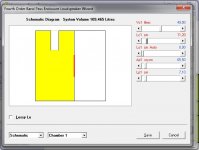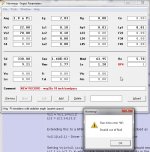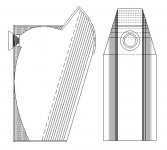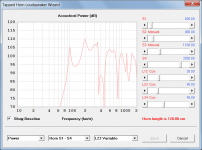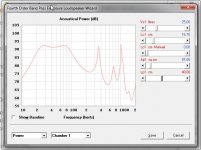Hi David
I did try and have the bandpass, however in past I did see the picture change with sliders, like the box volume, that way I did see where that slider was for.
Now it just go yellow but do not change when slider is adjusted.
Is this just oke, or did I find a bug.
Also I get error when saving record and program did exit.
When go to Lo1 slider the bos disappear to a small line, not shure it is a fault..
regards
I did try and have the bandpass, however in past I did see the picture change with sliders, like the box volume, that way I did see where that slider was for.
Now it just go yellow but do not change when slider is adjusted.
Is this just oke, or did I find a bug.
Also I get error when saving record and program did exit.
When go to Lo1 slider the bos disappear to a small line, not shure it is a fault..
regards
Attachments
Last edited:
Hi Newracer! Do you have an idea what type of cabinet design you would like ... ?
Hi Sharky! I do have a general idea. I'm trying to squeeze as much of the linearly-expanding BLH into a cabinet similar in dimension/aspect ratios to a Klipsch tower, and then remainder of the horn fires out the back toward a boundary wall by way of a bell that flares horizontally, reducing the aspect ratio toward a shorter, wider rectangle.
The crux of what I'd like to know first is, apart from the horn length question, whether folding to preserve volume is the first priority.
Attached is a previous attempt, with a side and front elevation, if it helps. This design increased the horn length from the Hornresp inputs by about 20%.
Attachments
Last edited:
Did find "Combined 1" today. But couldn´t find in the manual what the content is.
For systems with multiple outputs, the loudspeaker wizard power response chart "Combined 1" option shows each separate output and the combined output together on the one chart. The feature was added in Version 51.10 at the request of user 'Etocynned'.
Green line "Fundamental Fz" what is that versus the system tuning frequence?
It depends on how you define "tuning frequency", but for most systems the two frequency values are likely to be the same.
Hi Kees,
You are imagining things, that was never the case for band pass type systems .
.
That's how you know what the slider is for.
It appears that the record has been corrupted. I have no idea how people are managing to do this. I have never corrupted a record, no matter how hard I try.
It's not a fault, its because some of the values you have specified are unrealistically small (ie. 0,10 and 0,01).
Kind regards,
David
however in past I did see the picture change with sliders, like the box volume,
You are imagining things, that was never the case for band pass type systems
that way I did see where that slider was for. Now it just go yellow
That's how you know what the slider is for.
Also I get error when saving record and program did exit.
It appears that the record has been corrupted. I have no idea how people are managing to do this. I have never corrupted a record, no matter how hard I try.
When go to Lo1 slider the bos disappear to a small line, not shure it is a fault..
It's not a fault, its because some of the values you have specified are unrealistically small (ie. 0,10 and 0,01).
Kind regards,
David
The crux of what I'd like to know first is, apart from the horn length question, whether folding to preserve volume is the first priority.
The first priority should be to preserve the rate of cross-sectional area expansion along the axial length of the folded horn wherever possible.
The first priority should be to preserve the rate of cross-sectional area expansion along the axial length of the folded horn wherever possible.
Because folding is not able to be nor could it be represented in a sim that would need a frequency to assign it in many ways a person would otherwise mislead them selves? If i design a qw tuned pipe and use a pipe harmonic calc to fold at and its never going to represent those as the pressure nulls if in the fold or ‘anywhere if trying to put it in a place except for the s2 location as a driver entry or the L45 segment? After a tapped driver? what about the exact middle of the s2-s3(or s4) sum in TH sims? Is that a significant location because its halfway in the FB and acknowledged by the math inside for anything in the backwave or however the sim applies the various Z and 12 or so details it uses to define it?
Backwave from the mouth to tap throat entry or minus the actual exit to mouth and or throat closed end to s2 ?
So much theory and variety of ideas to to consider and then only ones that matter to me or that i will consider are the ones i know are exactly as David Mcbean was able to allow me to stick into his learning tool and search for a way to make that pipe null in a wooden pipe or a pipe null at the tapped mouth driver entry?? Or wheres the next if i make the L45 go big and long? This is part im not a acoustical engineer but it becomes more and more clear that gap was closed substantially the moment i realized i knew enough to start asking myself how hard my questions would be to voice if i actually was? the learning is insane. but it promotes the further and harder to present next ones ? im sorry but i wish that ends up reading better than it might confuse? or if there's a better way to ask? What will not be in the sim and cant because its part of a changing parameter (frequency or a few?)that might not be obvious to the guy asking ?
Last edited:
On the wish list, two cells with the f3 and f6 numbers presented on the Power and Schematic menus in the Loudspeaker wizard.
It's not going to happen
Determining the fundamental resonance frequency from the electrical impedance or diaphragm displacement is as far as I am prepared to go.
The f3 and f6 numbers sometimes have to be judgement calls - for example, where would you place the -3dB and -6dB frequency points in the attached response?
Attachments
So another " No it won´t happen" 
I do agree that there will be useless to give a value in such an output.
But with many other situations there will be a reasonable way of calculating a average value for the middle say 60% of a frequence span in an output (graph) and then point out where it exist one -f3 and -f6 Db decrease in LF end and a similar in the HF end of the graph. If they exist.
If it was economics it would be a typical Excel situation to do such a thing. Not really practical though when laborating back and forth and if one should export look in Excel, change in Hornresp, export, look in Excel in an endless loop.
For example as for me in post 11552.
Just a suggestion (as I get rather frustrated to trying to se the smaller changes in the spl curve while doing minor adjustment)
I do agree that there will be useless to give a value in such an output.
But with many other situations there will be a reasonable way of calculating a average value for the middle say 60% of a frequence span in an output (graph) and then point out where it exist one -f3 and -f6 Db decrease in LF end and a similar in the HF end of the graph. If they exist.
If it was economics it would be a typical Excel situation to do such a thing. Not really practical though when laborating back and forth and if one should export look in Excel, change in Hornresp, export, look in Excel in an endless loop.
For example as for me in post 11552.
Just a suggestion (as I get rather frustrated to trying to se the smaller changes in the spl curve while doing minor adjustment)
Last edited:
The first priority should be to preserve the rate of cross-sectional area expansion along the axial length of the folded horn wherever possible.
Ah, that is different from what I've been doing, but easier for me, actually. Thanks for that nugget, David!
that was never the case for band pass type systems
Just to clarify, the above statement applies to the schematic layout shown in the original post #11561.
BP4 and BP6 systems with offset drivers are correctly scaled.
I get rather frustrated to trying to se the smaller changes in the spl curve while doing minor adjustment
There are limits on the accuracy of the Hornresp predictions. If the changes in the power response are becoming so small that they are difficult to see, then any further "fine tuning" is unlikely to have a material effect on the measured results of the final constructed system anyway. Monitoring the fundamental resonance frequency value should in most cases be sufficient.
Good morning all.
I posted a thread in PA systems regarding Hornresp settings for multi-entry horns. If anyone with more experience would like to help out with my questions, I figure people traveling here probably work with the software regularly. I want to build a mid/low box and I haven't found anyone doing this yet. Can it work? Here's the thread link:
Link: Multi-Entry Horn Mid/Low Box Sim Help
I posted a thread in PA systems regarding Hornresp settings for multi-entry horns. If anyone with more experience would like to help out with my questions, I figure people traveling here probably work with the software regularly. I want to build a mid/low box and I haven't found anyone doing this yet. Can it work? Here's the thread link:
Link: Multi-Entry Horn Mid/Low Box Sim Help
If anyone with more experience would like to help out with my questions
Answers:
https://www.diyaudio.com/forums/pa-...ry-horn-low-mid-box-sim-help.html#post6498851
How can I use Help -> Input wizard so that it preserves loudspeaker settings (Sd, Cms, ... Rms, Le)?
Now if I have entered those and fill in Loudspeaker wizard like:
* half space
* Direct radiator
* Transmisison line
* any of Normal, Mass loaded or offset port
* any number of segments
* any flare profile
the end result is that loudspeaker settings are reset to some, maybe default values and the segment values are calculated based on those values.
Am I doing something wrong or is there maybe problem with wizard?
Now if I have entered those and fill in Loudspeaker wizard like:
* half space
* Direct radiator
* Transmisison line
* any of Normal, Mass loaded or offset port
* any number of segments
* any flare profile
the end result is that loudspeaker settings are reset to some, maybe default values and the segment values are calculated based on those values.
Am I doing something wrong or is there maybe problem with wizard?
Hi Kees,
You are imagining things, that was never the case for band pass type systems.
That's how you know what the slider is for.
It appears that the record has been corrupted. I have no idea how people are managing to do this. I have never corrupted a record, no matter how hard I try.
It's not a fault, its because some of the values you have specified are unrealistically small (ie. 0,10 and 0,01).
Kind regards,
David
Oke David thanks.
I have never did a bandpass, but did the other systems where I did see the change of the box with the sliders, that is reason why I thought that this was a error. But oke now I now and problem solved, sorry that I did doubt your beautifull program.
The corruption of the file, as you say your run never into it I presume it is just a pc writing error on disk as windows is a terrible multitasking options, when double writes occur, most because of a interacting with some other software.
I had this just once by the way.
Attachments
How can I use Help -> Input wizard so that it preserves loudspeaker settings (Sd, Cms, ... Rms, Le)?
The Input Wizard sets up an input parameters "template" for the specified loudspeaker system. The default parameter values generated by the wizard need to be changed by the user to match the actual system being simulated. The Input Wizard does not do the design work for you - if it did, it would have been called the Design Wizard
As far as driver parameter values are concerned, copy the details of the actual driver you wish to use to the Driver Database, and then paste the driver details back into records as necessary, rather than manually re-entering the individual parameter values each time.
Glad you took the pain David
Now its a simple task to calculate the below design.
1)
The next step is the room (and the baffle) in combination with the cabinets driver and port.
In the program one can select the position of the cabinet for simulating the spl etc. Against a wall or in the middle of a floor are two of them. Somewhere in between, back side 0,2-0,5 m from the wall is the most common position for a speaker. Also a cabinet port can be positioned on the front, underneath or at the back.
The above wall distance and position of the port is not something that can be selected in the program here. If i proceed to another program (VituixCAD for example) they sometimes can compensate for room, position and baffle. But then I walk away from the horn design from Hornresp. Is there a good process of how to adjust the horn design by the use of both Hornresp and a program compensating for the room (, baffle) and port position without loosing the advantages of Hornresp (and the other porgram)?
2)
What is your best suggestion of hos to get a more detailed, zoomed in, spl curve of a critical area? An output to for example Excel would ease the process, but that might be other ways that you guys use.
You are getting lost in the details of what you are trying to make.
It makes zero difference in a real life design what that right angle does in the flow path. The angled plate behind the driver is good practice. A non parallel wall is best as the reflections through a cone can be nearly as loud as those coming from the front face of the cone.
The Input Wizard sets up an input parameters "template" for the specified loudspeaker system. The default parameter values generated by the wizard need to be changed by the user to match the actual system being simulated. The Input Wizard does not do the design work for you - if it did, it would have been called the Design Wizard.
As far as driver parameter values are concerned, copy the details of the actual driver you wish to use to the Driver Database, and then paste the driver details back into records as necessary, rather than manually re-entering the individual parameter values each time.
Ok David, now I get it. And it makes perfect sense
Thanks for the tip for copying driver parameters. You wrote great software and your support for end users is excelent.

- Home
- Loudspeakers
- Subwoofers
- Hornresp
